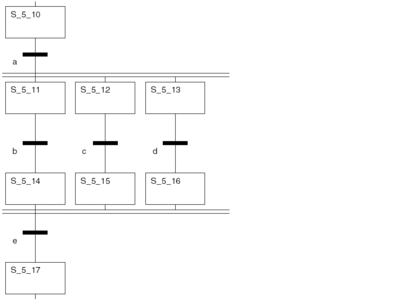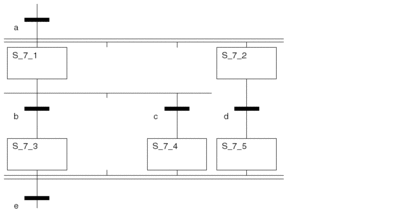Parallel Strings
With parallel branches, switching a single transition leads to a parallel activation of more than one (maximum 32) steps (branches). This applies with Single-Token as well as with Multi-Token
Processing Parallel Strings:

If... |
Then |
|---|---|
If |
then a sequence runs from |
If steps |
then the strings run independently of one another. |
If |
then a sequence is run from |
Terminating a Parallel Branch with an Alternative Merge
Terminating a parallel branch can also be done with an alternative merge instead of a parallel merge with Multi-Token.
Terminating a Parallel String with an Alternative Branch (variation 1):

If... |
Then |
||
If the transition condition |
then a sequence runs
to |
||
If steps |
then the strings run independently of one another. |
||
If transition condition |
then a sequence runs
to |
||
A second token is created
by the sequence running on the alternative merge out of the parallel
string. The two tokens are running parallel to one another, i.e. |
|||
Token 1 (S_5_3) |
Token 2 (S_5_2) |
||
If... |
Then |
If... |
Then |
Step |
Step |
||
If the transition condition |
then a sequence runs to |
||
If If |
|||
Terminating a Parallel String with an Alternative Branch (variation 2):

If... |
Then |
||
If the transition condition |
then a sequence runs
to |
||
A second token is created
by the sequence running on the alternative merge out of the parallel
string. These two tokens are now running parallel to one another,
i.e. |
|||
Token 1 (S_5_2) |
Token 2 (S_5_1) |
||
If... |
Then |
If... |
Then |
Step |
Step |
||
If transition condition |
then a sequence runs to |
||
If If |
|||
Using an Alternative Branch in a Parallel String
If one single alternative branch is used in a parallel string, it may block the string.
Using an Alternative Branch in a Parallel String:

If... |
Then |
|---|---|
If transition condition |
then a sequence is run to |
If steps |
then the strings run independently of one another. |
If transition condition |
then a sequence runs to |
If transition condition |
then a sequence runs to |
Since (Either Therefore This block can be removed for example, by a second timed token
that runs via transition |
|


